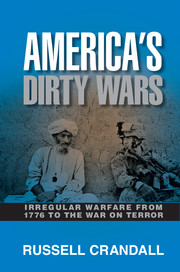Book contents
- Frontmatter
- Dedication
- Contents
- List of Figures
- Acknowledgments
- 1 Introduction
- 2 Irregular Warfare 101
- Part One The American Revolution to Chasing Sandino, 1776–1930s
- Part Two The Cold War, 1940s–1989
- Part Three Latin America and the Cold War, 1950s–1980s
- Part Four Post–Cold War, 1990s–2000s
- 26 Dirty Wars after the Cold War
- 27 Colombia
- 28 Iraq
- 29 Intermezzo
- 30 Post-9/11 COIN in the Philippines
- 31 Intermezzo
- 32 The Longest War
- 33 The Fall of Muammar Qaddafi, 2011
- 34 Intermezzo
- 35 Conclusion
- Epilogue “I Feel More Like a Monster”
- Notes
- Bibliography
- Index
32 - The Longest War
America in Afghanistan
Published online by Cambridge University Press: 05 July 2014
- Frontmatter
- Dedication
- Contents
- List of Figures
- Acknowledgments
- 1 Introduction
- 2 Irregular Warfare 101
- Part One The American Revolution to Chasing Sandino, 1776–1930s
- Part Two The Cold War, 1940s–1989
- Part Three Latin America and the Cold War, 1950s–1980s
- Part Four Post–Cold War, 1990s–2000s
- 26 Dirty Wars after the Cold War
- 27 Colombia
- 28 Iraq
- 29 Intermezzo
- 30 Post-9/11 COIN in the Philippines
- 31 Intermezzo
- 32 The Longest War
- 33 The Fall of Muammar Qaddafi, 2011
- 34 Intermezzo
- 35 Conclusion
- Epilogue “I Feel More Like a Monster”
- Notes
- Bibliography
- Index
Summary
In counterinsurgency the population is the prize, and protecting and controlling it is the key activity. The war, therefore, is where the people are: you win or lose it a village at a time, and you secure villages and gain access to the people by controlling valleys, roads, and the heights that overlook them, in that order of priority.
– Counterinsurgency practitioner David KilcullenThe Americans [in Afghanistan] intended to separate the people from the insurgents. Instead, the insurgents succeeded in separating the people from the Americans.
– War reporter Bing West[In Afghanistan] we developed a hunter mentality. This was a great place if you’re a Marine infantryman.
– U.S. Marine Captain Nikolai Johnson, commander of Kilo CompanyOn the morning of July 13, 2008, at about 4:20 AM, a force of over 200 insurgents attacked a remote American patrol base near the village of Wanat in the Waigal Valley of Nuristan Province, Afghanistan. The small base was brand-new, its fortifications unfinished. Occupying it was one platoon – thirty-eight soldiers – from the U.S. Army’s 2nd Battalion, 173rd Airborne Brigade Combat Team (BCT), augmented by six combat engineers and three U.S. Marines acting as an embedded training team (ETT) for a twenty-four-man detachment of the Afghan National Army. Using combined arms tactics and employing a blistering array of mortars, light machine guns, rocket-propelled grenades, and snipers, the mostly Taliban fighters battered the American and Afghan forces.
The insurgents navigated through a nearby village to get close to the patrol base and at one point managed to breach the American perimeter. The brunt of the attack targeted the Americans’ heavy weapons, quickly neutralizing both their mortar position and their TOW (Tube-launched, Optically tracked, Wire-guided) missile launcher. The insurgents also rendered the Americans’ Mk. 19 grenade launchers ineffective by moving close enough to the base to be within the minimum arming distance of the 40-millimeter high-explosive rounds. At the same time, the insurgents isolated the base’s observation post, positioned roughly 75 meters from the patrol base, and put their remaining attention on the nine U.S. soldiers there, killing several and compelling the main force at the patrol base to attempt to reach and evacuate the wounded, which in turn led to two more American fatalities, including 1st Lieutenant Jonathan Brostrom, the American platoon commander.
- Type
- Chapter
- Information
- America's Dirty WarsIrregular Warfare from 1776 to the War on Terror, pp. 412 - 441Publisher: Cambridge University PressPrint publication year: 2014



